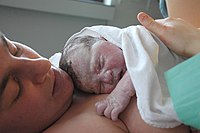
Photo from wikipedia
STUDY OBJECTIVE To compare the efficacy and reproductive outcomes of an ultrasound-guided manual vacuum aspiration (MVA) procedure with the widely accepted operative hysteroscopic (OH) procedure in the removal of retained… Click to show full abstract
STUDY OBJECTIVE To compare the efficacy and reproductive outcomes of an ultrasound-guided manual vacuum aspiration (MVA) procedure with the widely accepted operative hysteroscopic (OH) procedure in the removal of retained products of conception (RPOCs) after normal vaginal delivery. DESIGN A retrospective cohort study (Canadian Task Force classification II-2). SETTING A university-affiliated tertiary medical center. PATIENTS Eighty-six patients after normal vaginal delivery diagnosed with RPOCs from 2005 through 2015. This study was approved by the local institutional review board. INTERVENTIONS Treatment with either MVA or OH for patients diagnosed with RPOCs. MEASUREMENTS AND MAIN RESULTS Of 86 patients, 23 underwent remnant removal by ultrasound-guided MVA using a 6- to 7-mm catheter in a "see and treat" office procedure. Sixty-three patients underwent remnant removal using the OH procedure. Follow-up included sonographic examination 3 to 5 weeks after the procedure and long-term follow-up on complications and reproductive outcomes. Successful remnant evacuation and the overall complications rates were similar when comparing the MVA group and the OH group (95.7% vs 96.8% and 4.3% vs 4.7%, respectively). Conception rates and miscarriage rates were comparable in the MVA and OH groups (78.6% vs 72.2% and 9.1% vs 14.8%, respectively). CONCLUSION Preliminary results from 23 patients suggest that MVA is an efficient procedure with low complication rates and satisfactory reproductive outcomes. It does not require anesthesia or operating room facilities, allowing an immediate and inexpensive "see and treat" option for RPOCs. Further larger controlled trials are required.
Journal Title: Journal of minimally invasive gynecology
Year Published: 2017
Link to full text (if available)
Share on Social Media: Sign Up to like & get
recommendations!